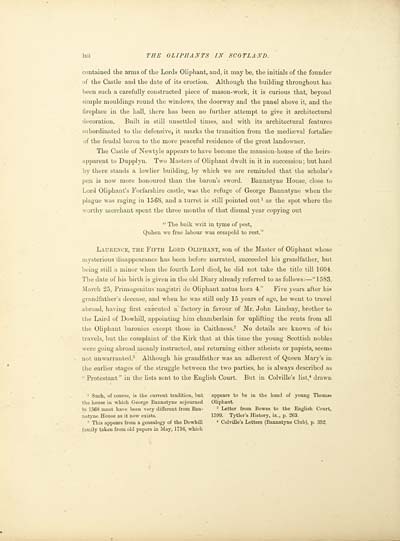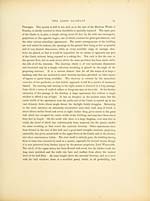Download files
Complete book:
Individual page:
Thumbnail gallery: Grid view | List view

Ixii THE OLIPHANTS IN SCOTLAND.
contained the arms of the Lords Oliphant, and, it may be, the initials of the founder
of the Castle and the date of its erection. Although the building throughout has
been such a carefully constructed piece of mason-work, it is curious that, beyond
simple mouldings round the windows, the doorway and the panel above it, and the
fireplace in the hall, there has been no further attempt to give it architectural
decoration. Built in still unsettled times, and with its architectural features
subordinated to the defensive, it marks the transition from the mediaeval fortalice
of the feudal baron to the more peaceful residence of the great landowner.
The Castle of Newtyle appears to have become the mansion-house of the heirs-
apparent to Dupplyu. Two Masters of Oliphant dwelt in it in succession ; but hard
by there stands a lowlier building, by which we are reminded that the scholar's
pen is now more honoured than the baron's sword. Bannatyne House, close to
Lord Oliphant's Forfarshire castle, was the refuge of George Bannatyne when the
plague was raging in 1568, and a turret is still pointed out 1 as the spot where the
worthy merchant spent the three months of that dismal year copying out
" The buik writ in tyme of pest,
Quhen we frae labour was compeld to rest."
Laurence, the Fifth Lord Oliphant, son of the Master of Oliphant whose
mysterious disappearance has been before narrated, succeeded his grandfather, but
being still a minor when the fourth Lord died, he did not take the title till 1604.
The date of his birth is given in the old Diary already referred to as follows: — "1583,
March 25, Primogenitus magistri de Oliphant natus hora 4." Five years after his
grandfather's decease, and when he was still only 15 years of age, he went to travel
abroad, having first executed a factory in favour of Mr. John Lindsay, brother to
the Laird of Dowhill, appointing him chamberlain for uplifting the rents from all
the Oliphant baronies except those in Caithness. 2 No details are known of his
travels, but the complaint of the Kirk that at this time the young Scottish nobles
were going abroad meanly instructed, and returning either atheists or papists, seems
not unwarranted. 3 Although his grandfather was an adherent of Queen Mary's in
the earlier stages of the struggle between the two parties, he is always described as
" Protestant" in the lists sent to the English Court. But in Colville's list, 4 drawn
1 Such, of course, is the current tradition, but appears to be in the hand of young Thomas
the house in which George Bannatyne sojourned Oliphant.
in 1568 must have been very different from Ban- 3 Letter from Bowes to the English Court,
natyne House as it now exists. 1599. Tytler's History, ix., p. 263.
2 This appears from a genealogy of the Dowhill 4 Colville's Letters (Bannatyne Club), p. 352,
family taken from old papers in May, 1716, which
contained the arms of the Lords Oliphant, and, it may be, the initials of the founder
of the Castle and the date of its erection. Although the building throughout has
been such a carefully constructed piece of mason-work, it is curious that, beyond
simple mouldings round the windows, the doorway and the panel above it, and the
fireplace in the hall, there has been no further attempt to give it architectural
decoration. Built in still unsettled times, and with its architectural features
subordinated to the defensive, it marks the transition from the mediaeval fortalice
of the feudal baron to the more peaceful residence of the great landowner.
The Castle of Newtyle appears to have become the mansion-house of the heirs-
apparent to Dupplyu. Two Masters of Oliphant dwelt in it in succession ; but hard
by there stands a lowlier building, by which we are reminded that the scholar's
pen is now more honoured than the baron's sword. Bannatyne House, close to
Lord Oliphant's Forfarshire castle, was the refuge of George Bannatyne when the
plague was raging in 1568, and a turret is still pointed out 1 as the spot where the
worthy merchant spent the three months of that dismal year copying out
" The buik writ in tyme of pest,
Quhen we frae labour was compeld to rest."
Laurence, the Fifth Lord Oliphant, son of the Master of Oliphant whose
mysterious disappearance has been before narrated, succeeded his grandfather, but
being still a minor when the fourth Lord died, he did not take the title till 1604.
The date of his birth is given in the old Diary already referred to as follows: — "1583,
March 25, Primogenitus magistri de Oliphant natus hora 4." Five years after his
grandfather's decease, and when he was still only 15 years of age, he went to travel
abroad, having first executed a factory in favour of Mr. John Lindsay, brother to
the Laird of Dowhill, appointing him chamberlain for uplifting the rents from all
the Oliphant baronies except those in Caithness. 2 No details are known of his
travels, but the complaint of the Kirk that at this time the young Scottish nobles
were going abroad meanly instructed, and returning either atheists or papists, seems
not unwarranted. 3 Although his grandfather was an adherent of Queen Mary's in
the earlier stages of the struggle between the two parties, he is always described as
" Protestant" in the lists sent to the English Court. But in Colville's list, 4 drawn
1 Such, of course, is the current tradition, but appears to be in the hand of young Thomas
the house in which George Bannatyne sojourned Oliphant.
in 1568 must have been very different from Ban- 3 Letter from Bowes to the English Court,
natyne House as it now exists. 1599. Tytler's History, ix., p. 263.
2 This appears from a genealogy of the Dowhill 4 Colville's Letters (Bannatyne Club), p. 352,
family taken from old papers in May, 1716, which
Set display mode to:
![]() Universal Viewer |
Universal Viewer | ![]() Mirador |
Large image | Transcription
Mirador |
Large image | Transcription
Images and transcriptions on this page, including medium image downloads, may be used under the Creative Commons Attribution 4.0 International Licence unless otherwise stated. ![]()
| Histories of Scottish families > Oliphants in Scotland > (92) |
|---|
| Permanent URL | https://digital.nls.uk/95436323 |
|---|
| Description | A selection of almost 400 printed items relating to the history of Scottish families, mostly dating from the 19th and early 20th centuries. Includes memoirs, genealogies and clan histories, with a few produced by emigrant families. The earliest family history goes back to AD 916. |
|---|

